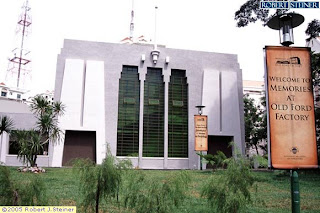Travelogue - Bukit Timah
Monday, March 21, 2011
Experience in writing A Travelogue for Tourists and our Future Generations
I enjoyed researching about the history of the places and finding photos of it. The history of the places i had chosen were interesting, especially the one about the old ford factory.The process is challenging as it requires me to double check with other sources so the information given would not be wrong.One of the challenges faced was finding past pictures of the attraction.They are hard to find and are rarely found online. I managed to find the one from Old Ford Factory as it was an important historical site for Singapore during the World War II. One area that i could do better if i could do it again is that i would go out and take pictures of the attraction i did not do so this time as i did not know what to take.
A Travelogue for Tourists and Our Future Generations
Bukit Timah Nature Reserve
History:In 1882, Nathaniel Cantley, then Superintendent of the Singapore Botanic Gardens, was appointed by the Government of the Straits Settlements to write a statement on the forests of the settlements. Several forest reserves were created beacuse of cartley's recommendation. Bukit Timah was one of the first forest reserves established in 1883.
History:Bukit Batok was a sleepy rural are with farms factory and forests. In 1950, granite quarrying was one of the early activities. Bukit Batok actually means 'coughing hills' in Malay as the blasting made the hills appear to be coughing. Public housing in the area started in the 1970s.
History:In 1882, Nathaniel Cantley, then Superintendent of the Singapore Botanic Gardens, was appointed by the Government of the Straits Settlements to write a statement on the forests of the settlements. Several forest reserves were created beacuse of cartley's recommendation. Bukit Timah was one of the first forest reserves established in 1883.
All the reserves were worked for their timber except Bukit Timah Nature Reserve. The reserves had been depleted due to the economic pressure for development by1937. However, three areas, including the Bukit Timah Reserve, were retained for the protection of flora and fauna under the management of the Singapore Botanic Gardens.
reference:http://en.wikipedia.org/wiki/Bukit_Timah_Nature_Reserve
 | |||||
| Now Bukit Timah Nature Reserve |
Past Photo is Unavailable
Bukit Batok Nature Park
History:Bukit Batok was a sleepy rural are with farms factory and forests. In 1950, granite quarrying was one of the early activities. Bukit Batok actually means 'coughing hills' in Malay as the blasting made the hills appear to be coughing. Public housing in the area started in the 1970s.
The Japanese built two memorials for their war dead and the allied forces on the top of the hill. They demolished both.All that remains today are two pillars and 120 concrete steps. The National Heritage Board had erected a plaque highlighting the significance of the site.
refrence:http://www.wildsingapore.com/places/bbnp.htm
 | |
| Now Bukit Batok Nature Park |
Past Photo is Unavailable
Old Ford Factory
History:The Ford Motor Factory began its illustrious history in October 1941, as the first Ford vehicle assembly plant in Southeast Asia. Situated in a location close to the Malayan railway line, it allowed for transportation of goods to and from the docks at Tanjong Pagar. Its close proximity to Bukit Timah Road, the main road linking Singapore to Malaya, and ultimately to the rest of mainland Southeast Asia, also provided an alternate transport route.
During the Malayan Campaign, the Factory’s modern assembly equipment was used by the Royal Air Force to assemble fighter planes. The planes came in parts that were shipped to Singapore in crates. However, most of these aircraft never fulfilled their destiny of defending Malaya. They were flown out of Singapore towards the end of January 1942, when prospects for Singapore looked bleak.
The Ford Motor Factory most notably served as the venue for the formal surrender of Malaya by the British General Officer Commanding Malaya, Lt.-Gen. Arthur Ernest Percival, to the Japanese Commander of the 25th Army, Gen. Yamashita Tomoyuki.
In the final tense hours before the surrender on 15 February 1942, Yamashita waited at the Factory while Percival and his aides discussed their options at the Battlebox, a bunker at Fort Canning. Percival and his troops then set off on their journey from Fort Canning Hill to the Ford Motor Factory.
The British surrender marked the decline of the British empire in Asia and the beginning of the Japanese Occupation, the darkest period in Singapore’s modern history.
During the Japanese Occupation, the Factory was designated as a butai or Japanese facility. Nissan, which was then a prominent zaibatsu or Japanese multinational company, took over the plant to assemble military trucks and other vehicles for the Japanese occupying forces.
The Ford Motor Factory resumed operations after the war in 1947 and was finally shut down in June 1980. Remains of the Factory were gazetted as a national monument on 15 February 2006.
Source and Official site:http://www.s1942.org.sg
 |
| Now Memories of Old Ford Factory |
 | |||||
| Past Old Ford Factory |
Subscribe to:
Comments (Atom)
